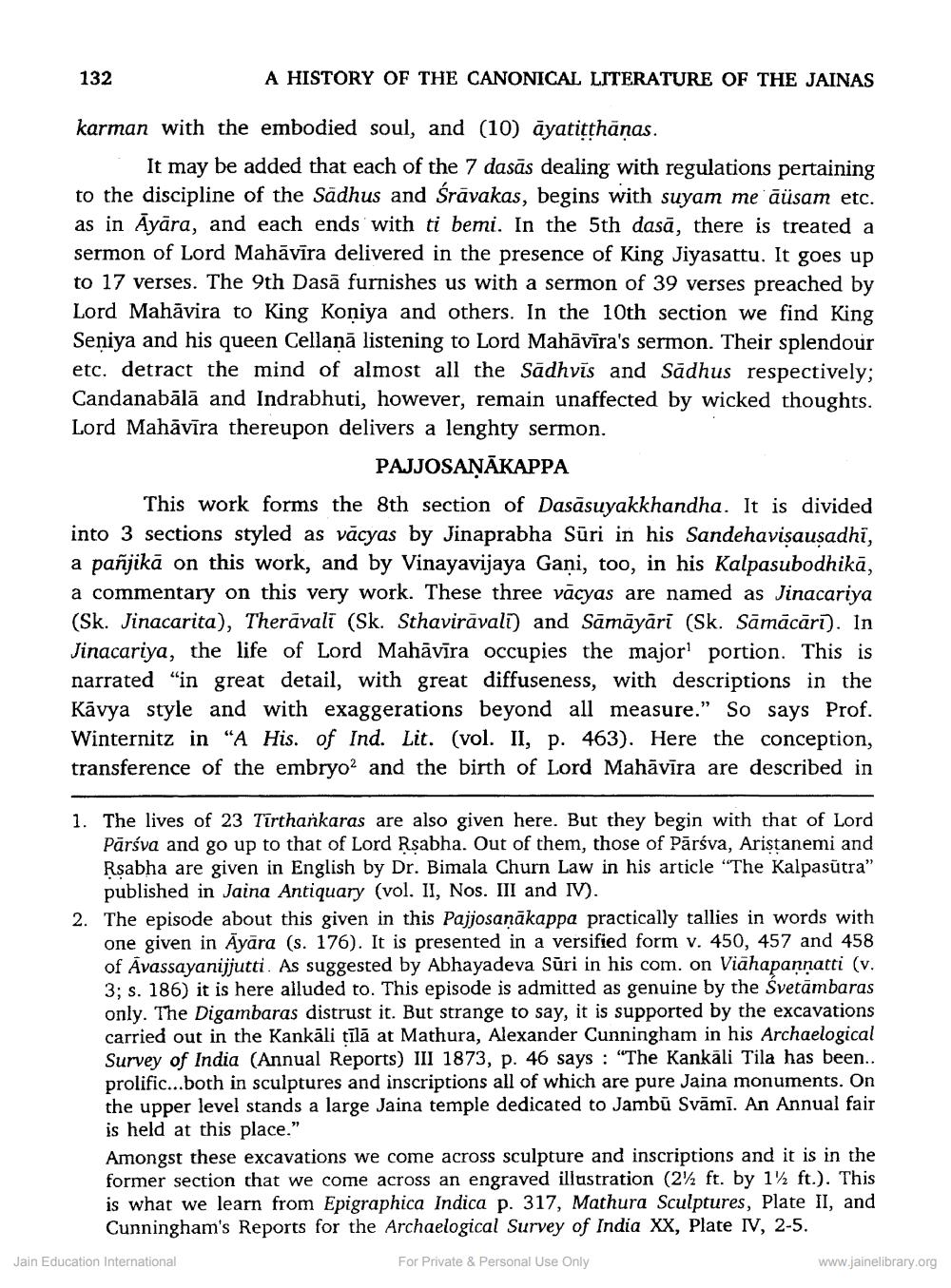________________
132
A HISTORY OF THE CANONICAL LITERATURE OF THE JAINAS
karman with the embodied soul, and (10) āyatitthāṇas.
It may be added that each of the 7 dasās dealing with regulations pertaining to the discipline of the Sädhus and Śrāvakas, begins with suyam me ausam etc. as in Ayara, and each ends with ti bemi. In the 5th dasā, there is treated a sermon of Lord Mahāvīra delivered in the presence of King Jiyasattu. It goes up to 17 verses. The 9th Dasā furnishes us with a sermon of 39 verses preached by Lord Mahāvira to King Koniya and others. In the 10th section we find King Seniya and his queen Cellaņā listening to Lord Mahāvīra's sermon. Their splendour etc. detract the mind of almost all the Sadhvīs and Sädhus respectively; Candanabālā and Indrabhuti, however, remain unaffected by wicked thoughts. Lord Mahāvīra thereupon delivers a lenghty sermon.
PAJJOSAŅĀKAPPA This work forms the 8th section of Dasāsuyakkhandha. It is divided into 3 sections styled as vācyas by Jinaprabha Sūri in his Sandehavisausadhi, a pañjikā on this work, and by Vinayavijaya Gani, too, in his Kalpasubodhikā, a commentary on this very work. These three vācyas are named as Jinacariya (Sk. Jinacarita), Therāvali (Sk. Sthavirāvali) and Sāmāyārī (Sk. Sāmācāri). In Jinacariya, the life of Lord Mahāvīra occupies the major portion. This is narrated "in great detail, with great diffuseness, with descriptions in the Kāvya style and with exaggerations beyond all measure.” So says Prof. Winternitz in "A His. of Ind. Lit. (vol. II, p. 463). Here the conception, transference of the embryo? and the birth of Lord Mahāvīra are described in
1. The lives of 23 Tirthankaras are also given here. But they begin with that of Lord
Pārsva and go up to that of Lord Rsabha. Out of them, those of Pārśva, Aristanemi and Rsabha are given in English by Dr. Bimala Churn Law in his article "The Kalpasūtra" published in Jaina Antiquary (vol. II, Nos. III and IV). The episode about this given in this Pajjosaņākappa practically tallies in words with one given in Āyāra (s. 176). It is presented in a versified form v. 450, 457 and 458 of Avassayanijjutti. As suggested by Abhayadeva Sūri in his com. on Viāhapannatti (v. 3; s. 186) it is here alluded to. This episode is admitted as genuine by the Svetāmbaras only. The Digambaras distrust it. But strange to say, it is supported by the excavations carried out in the Kankāli tīlā at Mathura, Alexander Cunningham in his Archaelogical Survey of India (Annual Reports) III 1873, p. 46 says : "The Kankāli Tila has been.. prolific...both in sculptures and inscriptions all of which are pure Jaina monuments. On the upper level stands a large Jaina temple dedicated to Jambu Svāmī. An Annual fair is held at this place." Amongst these excavations we come across sculpture and inscriptions and it is in the former section that we come across an engraved illustration (27 ft. by 1 ft.). This is what we learn from Epigraphica Indica p. 317, Mathura Sculptures, Plate II, and Cunningham's Reports for the Archaelogical Survey of India XX, Plate IV, 2-5.
Jain Education International
For Private & Personal Use Only
www.jainelibrary.org




